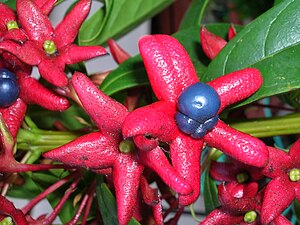Note: This is a project under development. The articles on this wiki are just being initiated and broadly incomplete. You can Help creating new pages.
Difference between revisions of "Clerodendrum indicum - Bharangi, Tubeflower"
(→Chemical Composition) |
(→References) |
||
| Line 69: | Line 69: | ||
<references> | <references> | ||
| − | <ref name="chemical composition">[ | + | <ref name="chemical composition">[http://gbpihedenvis.nic.in/PDFs/Glossary_Medicinal_Plants_Springer.pdf"Chemical constituents"]</ref> |
<ref name="Leaf">http://keralaplants.in/flowering-plants-kerala-dvd.aspx </ref> | <ref name="Leaf">http://keralaplants.in/flowering-plants-kerala-dvd.aspx </ref> | ||
<ref name="How to plant/cultivate">[http://tropical.theferns.info/viewtropical.php?id=Clerodendrum+indicum"Cultivation detail"]</ref> | <ref name="How to plant/cultivate">[http://tropical.theferns.info/viewtropical.php?id=Clerodendrum+indicum"Cultivation detail"]</ref> | ||
Revision as of 11:27, 25 June 2019
Clerodendrum indicum is a semideciduous, perennial plant with stems that are sometimes herbaceous but more often become woody, with the plant adopting the habit of a shrub or a small tree. Growing from an aggressively suckering, stoloniferous rootstock, the plant can be up to 3 metres tall, the stems usually very straight or arching, mostly unbranched, hollow.
Contents
- 1 Uses
- 2 Parts Used
- 3 Chemical Composition
- 4 Common names
- 5 Properties
- 6 Habit
- 7 Identification
- 8 List of Ayurvedic medicine in which the herb is used
- 9 Where to get the saplings
- 10 Mode of Propagation
- 11 How to plant/cultivate
- 12 Commonly seen growing in areas
- 13 Photo Gallery
- 14 References
- 15 External Links
Uses
Asthma, Skin problems, Cough, Syphilitic rheumatism, Abdominal tumors, Tuberculosis, Chronic respiratory disorder, Jaundice, Disorder of liver, Joint pain, Headache, Worm infetsation, Digestive fire.
Parts Used
Chemical Composition
The leaves contain flavonoids—scutellarein (0.5%), hispidulin (0.1%) and their 7-O-glucuronides; also sterols. Flowers contain beta-sitosterol and triterpenoids. The bark yields hexitol and sorbitol. [1]
Common names
| Language | Common name |
|---|---|
| Kannada | angaravalli, baaleya, bangaali bhaarangi |
| Hindi | barangi, chingari |
| Malayalam | cerutekku |
| Tamil | isangu, kavalai, kovalai, narivalai |
| Telugu | bhaarangi, bharangi |
| Marathi | NA |
| Gujarathi | NA |
| Punjabi | NA |
| Kashmiri | NA |
| Sanskrit | bhargi, bharangi, brahmanyastika, phangi |
| English | Tubeflower, Turk's-Turban, Sky Rocket, Bowing Lady |
Properties
Reference: Dravya - Substance, Rasa - Taste, Guna - Qualities, Veerya - Potency, Vipaka - Post-digesion effect, Karma - Pharmacological activity, Prabhava - Therepeutics.
Dravya
Rasa
Guna
Veerya
Vipaka
Karma
Prabhava
Habit
Identification
Leaf
| Kind | Shape | Feature |
|---|---|---|
| Simple | Lanceolate | Leaves in whorls of 3-4, 7-22 x 2-4 cm, linear-lanceolate or elliptic-lanceolate, base attenuate to acute, margin entire or more or less toothed, apex acute or acuminate, sessile or subsessile |
Flower
| Type | Size | Color and composition | Stamen | More information |
|---|---|---|---|---|
| Bisexual | Terminal panicles | White | 4 | Bracts foliaceous resembling the leaves in all respects but smaller; bracteoles 5-12 x 2-3 mm, linear. Calyx 5-partite, red, broadly campanulate; tube 4-6 mm long; lobes 5, 6-10 mm long, ovate, apex acute. Corolla white, hypocrateriform; tube slender, 8-13 cm long, curved; lobes 8-15 mm long, oblong or ovate-oblong, obtuse, reflexed. Stamens 4, exserted; filaments purple, slender; anthers oblong, c. 2.5 mm long, purple. Sytle filiform, purple; stigma shortly bifid. |
Fruit
| Type | Size | Mass | Appearance | Seeds | More information |
|---|---|---|---|---|---|
| Pyrenes | Frit 4-lobed, blue-black, 1-1.3 cm across; pyrenes 1-4, 1-seeded; fruiting-calyx accrescent, fleshy, bright red. |
Other features
List of Ayurvedic medicine in which the herb is used
Where to get the saplings
Mode of Propagation
How to plant/cultivate
Succeeds in a moderately to very sunny position in ordinary garden soil[3]
Commonly seen growing in areas
Tropical area, Sub Tropical area
Photo Gallery
References
External Links
- Ayurvedic Herbs known to be helpful to treat Asthma
- Ayurvedic Herbs known to be helpful to treat Skin problems
- Ayurvedic Herbs known to be helpful to treat Cough
- Ayurvedic Herbs known to be helpful to treat Syphilitic rheumatism
- Ayurvedic Herbs known to be helpful to treat Abdominal tumors
- Ayurvedic Herbs known to be helpful to treat Tuberculosis
- Ayurvedic Herbs known to be helpful to treat Chronic respiratory disorder
- Ayurvedic Herbs known to be helpful to treat Jaundice
- Ayurvedic Herbs known to be helpful to treat Disorder of liver
- Ayurvedic Herbs known to be helpful to treat Joint pain
- Ayurvedic Herbs known to be helpful to treat Headache
- Ayurvedic Herbs known to be helpful to treat Worm infetsation
- Ayurvedic Herbs known to be helpful to treat Digestive fire
- Herbs with Seeds used in medicine
- Herbs with Stem used in medicine
- Herbs with Leaves used in medicine
- Herbs with Roots used in medicine
- Herbs with common name in Kannada
- Herbs with common name in Hindi
- Herbs with common name in Malayalam
- Herbs with common name in Tamil
- Herbs with common name in Telugu
- Herbs with common name in Sanskrit
- Herbs with common name in English
- Habit - Shrub
- Index of Plants which can be propagated by Seeds
- Index of Plants which can be propagated by Root cuttings
- Herbs that are commonly seen in the region of Tropical area
- Herbs that are commonly seen in the region of Sub Tropical area
- Herbs
- Lamiaceae




